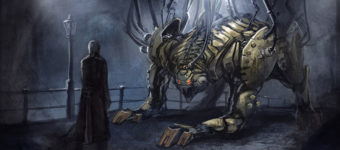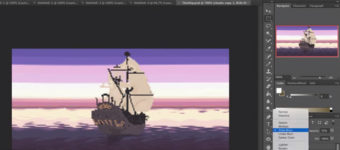Book Review: How to Become a Video Game Artist: The Insider’s Guide by Sam R. Kennedy


Concept art is a growing industry that branches into all areas of console and mobile gaming. As more people get into modern gaming there’s a greater demand for talented artists to build the video games of the future.
Sam Kennedy knows this well because he’s a veteran illustrator/concept artist with over 15 years experience.
He is well versed in the entire gaming industry and he spills lots of this insider info in his book How to Become a Video Game Artist: The Insider’s Guide to Landing a Job in the Gaming World.
This isn’t a book meant to teach you how to draw, paint, or construct ideas. This book won’t teach you how to design from scratch and it certainly won’t improve your ability to paint or render.
What it will teach you is the nuanced nature of the concept art industry. You’ll learn what it takes to become a concept artist or digital designer working on professional games for indie studios and AAA studios alike.
If you’re serious about becoming a concept artist then this book might be the best introduction to the business side of video game concept art.
Book Contents
Everything in this book is meant to help you land a job in the gaming industry. It’s ultimately geared towards creatives who want to paint, design, or model concepts for video games(either 2D or 3D artwork).
The early chapters explain the studio environment and what’s expected of a modern concept artist. You’ll also get about 10 pages explaining the required skills like art fundamentals, digital drawing, and storyboarding/animating for video games.
I think these early chapters are invaluable for anyone interested in the entertainment industry. Most technical requirements for concept artists fall to animators, illustrators, and vis dev artists working on movies.
If you fully understand what’s expected of you it’ll be easier to hone those skills before even applying for a job.
Once you get past the early chapters you’ll find game art jobs broken down into chapters with sub-sections for each one. Sam covers 6 game art jobs in their own chapters with lots of tips, resources, and artist profiles featuring real artists working in the industry.
Here’s a list of all the six jobs covered in this book.
- Concept Artist
- Environment Artist
- Character Artist
- Character Animator
- User Interface Artist
- Marketing Artist
Sam goes into great detail for each of these jobs explaining the unique requirements, day-to-day tasks, and sample job templates to show what questions you might face when looking for a job opening.
The artist profiles are exceptional and there’s a different artist profiled for each of these six career paths. Reading Sam’s advice is obviously useful. But it’s incredibly helpful to read what other working professionals have to say about their jobs.
In the last chapter Sam offers advice for improving your current skillset to reach the level of modern professional concept artists. He offers tips and suggestions for practicing from home and teaching yourself.
Beyond the resources and artist profiles you also get real product art scattered throughout the book.
You get to see examples of real studio assets for each of the six career paths. Some of these assets were created by Sam while others are from popular game studios.
Artwork is printed in high enough quality to really appreciate the detail of the work. Most game art is taken from hit series like Tom Clancy and World of Warcraft. By studying this art you can compare your work to the work of professionals to see where you stack up.
All of the content in this book is superb and I really value the detail of each chapter.
In total the book spans 160 pages so it’s not a long read. But every page is jam-packed with information about the career path of a video game artist.
Can This Help You?
Anyone that’s interested in the video game/entertainment industry will get a lot from reading this book.
One thing I noticed is that there’s not much info on props design for concept art. Props artists typically create weapons, vehicles, and other stationary items like tables and knick-knacks for interior environments.
It would’ve been nice to have more info for props concept art because it is a valuable piece to the game art career track. But an aspiring props concept artist could still learn a lot by reading this book.
I would recommend How to Become a Video Game Artist to anyone that’s already proficient in their artistic ability and needs the next step for breaking in. While there is a high demand for talented concept artists, the field is also flooded with talent. Supply exceeds demand so studios can have their pick of the litter.
Make sure your skills are on point and up to par with competitive art portfolios. If you’re not there yet just keep practicing.
But even if your portfolio isn’t quite there yet I’d still recommend this book. You can educate yourself about the industry and it may serve as an inspirational kick in the tush to get you practicing more often. However it can’t make you a better artist.
The only way to get better is to practice, study, and practice some more.
How To Become A Video Game Artist will be invaluable for anyone who wants an inside look into the gaming industry whether you hope to be employed in it or not.
Overview
The best part of Sam Kennedy’s book is the easy-to-follow writing style. Sam has a way of breaking down topics so that beginners can understand more about how the game art industry works.
I would definitely recommend Sam’s game art book to anyone who wants to break into the concept art industry. Lots of books make these vague promises but Sam really delivers.
You’ll learn a lot about the industry, concept art, and how to land your first studio job. You’ll learn what sorts of skills you need based on your preferred career track and you’ll get suggestions for how to improve those skills.
This is a powerful resource for anyone interested in the game art industry.
It’s a book you might find yourself coming back to frequently to re-read passages for advice and inspiration.











